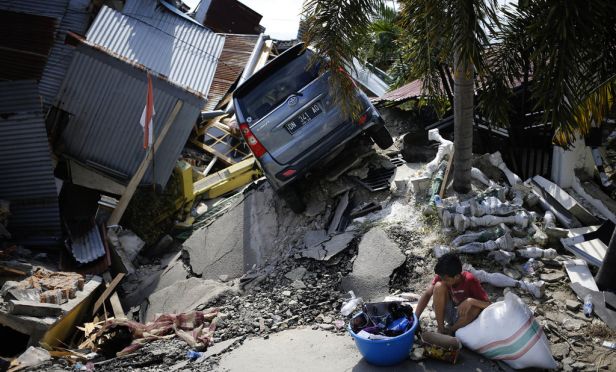 A boy sits with items salvaged from the ruins of a family member's house in the Balaroa neighborhood in Palu, Central Sulawesi, Indonesia Indonesia, Tuesday, Oct. 2, 2018. Desperation was visible everywhere Tuesday among victims receiving little aid in areas heavily damaged by a massive earthquake and tsunami, four days after the disaster devastated parts of Indonesia's central Sulawesi island. (AP Photo/Dita Alangkara)
A boy sits with items salvaged from the ruins of a family member's house in the Balaroa neighborhood in Palu, Central Sulawesi, Indonesia Indonesia, Tuesday, Oct. 2, 2018. Desperation was visible everywhere Tuesday among victims receiving little aid in areas heavily damaged by a massive earthquake and tsunami, four days after the disaster devastated parts of Indonesia's central Sulawesi island. (AP Photo/Dita Alangkara)
(Bloomberg) – The death toll from the Sulawesi earthquake and tsunami topped 1,200 as authorities scrambled to bring food and medicines to thousands displaced by Indonesia's deadliest such disaster in more than a decade.
|Flattened buildings, more than 60,000 displaced
Thousands of military and police personnel joined relief and rescue workers in the worst affected areas of Sulawesi island, now in its fourth day since the 7.4 magnitude earthquake and subsequent tsunami unleashed a trail of devastation. President Joko Widodo ordered officials to intensify relief and rescue operations and boost the supply of essential items as reports of looting of food and other goods emerged.
Recommended For You
Want to continue reading?
Become a Free PropertyCasualty360 Digital Reader
Your access to unlimited PropertyCasualty360 content isn’t changing.
Once you are an ALM digital member, you’ll receive:
- Breaking insurance news and analysis, on-site and via our newsletters and custom alerts
- Weekly Insurance Speak podcast featuring exclusive interviews with industry leaders
- Educational webcasts, white papers, and ebooks from industry thought leaders
- Critical converage of the employee benefits and financial advisory markets on our other ALM sites, BenefitsPRO and ThinkAdvisor
Already have an account? Sign In Now
© Touchpoint Markets, All Rights Reserved. Request academic re-use from www.copyright.com. All other uses, submit a request to [email protected]. For more inforrmation visit Asset & Logo Licensing.







